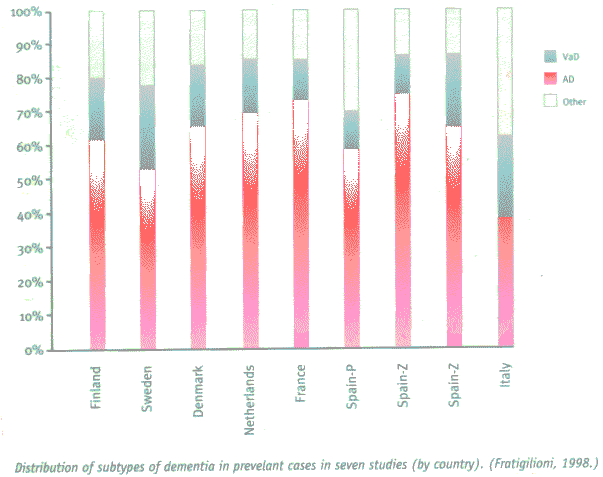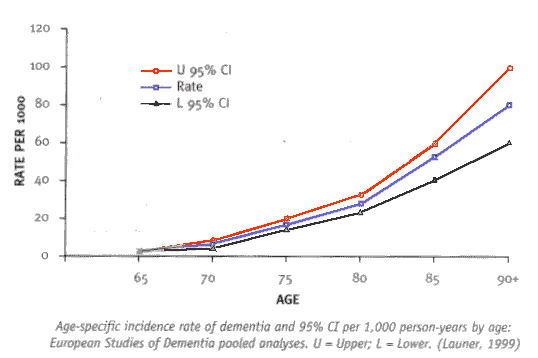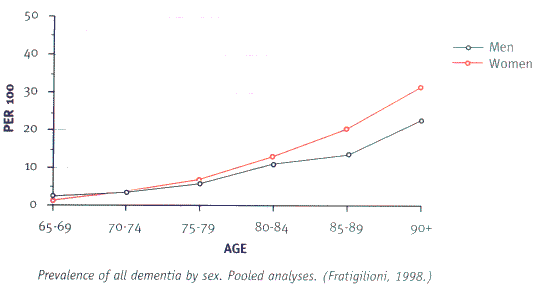The power of concentration has gone, along with the ability to form coherent sentences and to remember where she is, or has been. She does not know she has written 26 remarkable novels, as well as her books on philosophy; received honorary doctorates from the major universities; become a Dame of the British Empire.“
John Bayley, Iris, A Memoir, a loving homage to his late wife, Iris Murdoch, who had Alzheimer’s disease
The tragic plight of novelist and philosopher Iris Murdoch puts a human face on a growing problem throughout Europe and the rest of the world – the dramatic increase in Alzheimer’s disease and other forms of dementia as the population ages. Dementia is already responsible for significant social and economic costs, projected to rise exponentially in the coming decades as the elderly segment of the population continues to increase.
The challenge facing Europe on the eve of the millennium lies in developing an interdisciplinary combination of medical, clinical, social, economic, governmental and personal approaches to those with dementia and their families.
Our goals are to promote efforts to find communal solutions and interventions that preserve people’s humanity and functional independence and delay or prevent institutional care as long as possible
.Dementia is disabling not just to patients but to families, carers, communities and national healthcare systems. Despite considerable resources now targeted on biomedical research in neurodegenerative diseases, particularly on Alzheimer’s, no cure is in sight. Some palliative treatments are beginning to be available, however, and knowledge of neurological processes, especially among the elderly, is increasing rapidly.
Dementia is not caused by ageing, nor is it an inevitable part of the ageing process. It is more likely a combination of genetic processes, age-related decline and faulty neurological mechanisms.
(Ritchie, 1998). Dementia
“Dementia” is a general term for symptoms exhibited by people with various kinds of cognitive impairment. These symptoms may include impaired mental functioning in areas such as memory, learning, judgment, attention, concentration, language and thinking. They are often accompanied by personality and behavioural changes. Dementia may be caused by more than 60 different diseases. Alzheimer’s disease is the most common, accounting for well over 50 percent of all cases of dementia. (See separate section on Alzheimer’s disease.) The second most common form is vascular dementia, usually resulting from cerebrovascular diseases, such as successive strokes or lesions. Other dementias may be associated with such disorders as HIV infection, Parkinson’s disease, Creutzfeldt-Jakob disease (CJD) and alcoholism, or they can follow trauma.
Prevalence of Dementia“In the mid 1990s the European Union’s over 65 population represented about 15% of the population. Given the demographics of the post-war generation boom, the situation will only intensify. By 2020 the over 65s will make up more than 20% of the total population.” Eurolink Age 1995
The prevalence of Alzheimer’s disease and other kinds of dementia is difficult to establish because many cases go undiagnosed. It is estimated, however, that as of the year 2000, approximately eight million people among European Union Member States will have Alzheimer’s disease, according to Alzheimer Europe. Since Alzheimer’s accounts for only half the cases of dementia among people over 65 years of age, total estimates for dementia in Europe are closer to 16 million.
It is estimated that Alzheimer’s disease alone strikes 1 in 20 over age 65, or 5 percent of the population. Taken together, dementia affects more than one-quarter aged 85 and over and a third to a half of those aged 90 and over. The incidence of all dementias rises with age, nearly doubling every five years between the ages of 60 and 95, according to the 1991 EURODEM study of dementia in Europe. (Hofman 1991) In the most recent EURODEM analysis, the study samples showed an incidence rate of 2.5 per 1,000 person-years at 65 years of age, advancing to 85.6 for those 90 years of age and older. (Launer 1999)
As the population ages and people live longer, the prevelance of Alzheimer’s disease and other dementias is destined to grow. In 1990,older people comprised 15 percent of the population. in Italy and Germany.
By 2020, that percentage is projected to increase to nearly one-quarter of the population — 22.5 percent in Germany and 23.6 percent in Italy. (IBRD World Population) The situation is further complicated by a projected decline in the working age population.
| % 1990 Pop 65+ |
% 1990 Pop 75+ |
%Change 65+ by 2020 |
%Change 75+ by 2020 |
%Pop 65+ by 2020 |
%Pop 75+ by 2020 |
|
| Belgium | 15.0 | 6.7 | 34.6 | 27.6 | 20.3 | 8.5 |
| Germany | 14.9 | 7.2 | 45.0 | 45.1 | 22.5 | 10.9 |
| Holland | 13.2 | 5.6 | 74.9 | 68.7 | 21.5 | 8.8 |
| Ireland | 11.4 | 4.6 | 51.9 | 56.3 | 14.2 | 5.9 |
| Italy | 14.8 | 6.5 | 52.2 | 67.7 | 23.6 | 11.4 |
| Luxembourg | 13.6 | 6.0 | 69.2 | 65.2 | 20.9 | 9.0 |
| Sweden | 17.7* | 8.0* | 27.0* | 28.0* | 20.6* | 9.3* |
| UK | 15.7 | 6.8 | 32.0 | 35.3 | 19.8 | 8.8 |
| *Eurostat Demographic Services Source IBRD World Population 1994-5 |
||||||
The data clearly indicates differences by country in the proportion of the elderly in the population, ranging from 4.6 percent in Ireland to 7.2 percent in Germany and 8.0 percent in Sweden. For all countries there will be an increase in absolute numbers of elderly. The most rapid increases are expected in Italy, Luxembourg and The Netherlands, where the 75+ population is projected to increase by two-thirds over the next two decades. The most rapid growth will take place in the 80+ group. Since women outlive men, a disproportionate part of these elderly will be women. (Rasmussen, 1999).
Given the demographics, it is clear that each country is facing monumental costs for support services and institutional care, and loss of productivity from those who bear the burden of care in the home, primarily women.
In most countries, eighty percent of Alzheimer’s sufferers are cared for by unpaid, informal carers across most countries. However, these traditional support systems are severely challenged because of changing family patterns, and the declining ratio between older persons and available younger family carers. The prevailing trend is to shift responsibilities from public support policies back to the families, responsibilities for which families are unprepared ( Rasmussen, 1999). Dementia is a ‘rising tide’ and a ‘neglected problem’ at the same time.” (Hofman 1991)
Women and Dementia
Dementia is particularly difficult for women.
- Studies show that older women are more likely to suffer from the disorder. There are some indications that the lowering of estrogen levels following menopause may be a contributing factor in Alzheimer’s Disease. [Alzheimer’s Europe] Another factor may lie simply in the fact that women have longer life expectancies and are therefore more likely to suffer from illnesses related to ageing. There are three women for every two men between the ages of 65 and 79, and the ratio increases with each decade. More than twice as many women are over 80. ( EIWH, Women in Europe, 1996)
- Women are most often designated as primary carers and, more often than not, are unpaid. A European Parliament report called them “society’s hidden army of workers, often required to put in long hours, for little or no pay whatsoever, in working conditions which may be difficult or emotionally tiring.” (Mendonca, 1995).
- Women comprise the majority of paid carers, most of whom are at the lower end of the economic scale, as well as volunteers who help support patients and their families. This means they may bear the dual emotional burden of care giving both at home and at work.
- Women’s care-giving responsibilities may take them out of the labour market or prevent them from advancing professionally. This leaves them prone to multiple deprivation; low income, social isolation, and an insecure economic future.
- Women are also more vulnerable to the disease in later life when their economic condition is likely to be most at risk, particularly if they have been called upon to care for other family members.
- As part of this vicious cycle, women’s pensions, if they exist at all, are generally lower than men’s, resulting in greater deprivation at a time when they most need economic support.




